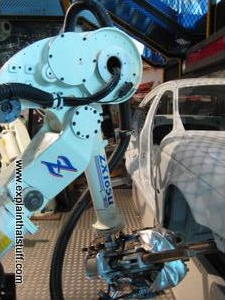Chariots thrived in the ancient Mediterranean and Middle-East. Steam-power was a product of 18th-century Britain. In the 19th century, French and German engineers built the first gasoline cars. At the start of the 20th century Henry Ford, an American, made simple cars people could afford. Ever since then, the miracle of the motor car has spread around the world... and changed the face of our planet.
People's wagon: 1940s: Germany
German dictator Adolf Hitler (1889–1945) gave Henry Ford a medal for making cars affordable. Inspired by the Model-T Ford, Hitler asked German auto-maker Dr Ferdinard Porsche to develop a simple people's car or "Volks Wagen" called the KDF (Kraft durch Freude or Strength through Joy). Renamed the Beetle, it sold over 20 million worldwide and was one of the most popular cars of the 20th century.

Photo: Small, basic cars like this Austin Mini, popular in the UK during the 1960s and 1970s, owed much to pioneering, affordable cars like the Model T-Ford and Volkswagen Beetle.
Status symbols: 1950s–1960s: America
Ford wanted to keep cars simple to keep them cheap. But his "any color so long as it's black" message fell out of favor: people wanted comfort and style. In the 1930s, cars became sleek, glamorous, and "streamlined"; inside, they boasted luxuries like automatic gears and window defrosters. The end of World War II brought cars inspired by planes. Swaggering "gas guzzlers" were given tail fins like jet fighters—and burned almost as much fuel!
Paving the way: 1930s–1950s: Europe and America
Many countries launched huge roadbuilding schemes in the mid-20th century. Hitler helped to pioneer Germany's high-speed Autobahns in the 1930s, while his Italian pal Benito Mussolini (1883–1945) greatly expanded the Italian network of autostrade. Britain didn't start building motorways until the 1950s, when America also reorganized its major roads into a simple numbered network called the Interstate Highway System.
Cuban Classics: 1950s: Cuba
Cuba has been cut-off from the United States since the Cuban revolution of 1959, so many Cubans still drive round in classic cars from the late 1950s. It's hard to buy new cars or spares for old ones!
Trabi trials (1950s–1980s): East Germany
Before the fall of the Berlin Wall in 1989, eastern Europeans zipped around in 3 million ugly little cars called Trabants (or "Trabis"). They were cheap and cheerful—even cool in some ways, with recycled plastic body parts that lasted nearly 30 years. But their engines chugged like mowers and smoke belched from their exhausts. When communism collapsed, people drove their Trabants to the scrap heap at top speed. Only to find the plastic bits couldn't be recycled.
Big Sheik Out: 1970s: Middle East
In 1973, oil-rich states in the Middle East began to restrict exports—turning off the tap that supplied the world with oil. There were sharp hikes in fuel prices and queues of cars snaking from gas stations were a familiar sight.
Sugar cars: 1970s– : Brazil
When the 1973 oil crisis hit home, the Brazilian government launched a major project to run the country's cars on ethanol made from sugar beet. Almost 30,000 filling stations in Brazil now sell ethanol, which supplies a fifth of the country's fuel.
First robot carmaker: 1961: Ewing, New Jersey, USA
Henry Ford pioneered automation, but General Motors took it a quantum leap further in 1961. That's when the first-ever car-making robot started building car bodies at the GM plant in Ewing New Jersey.

Photo: A modern car-welding robot at Think Tank, the museum of science in Birmingham, England.
Big in Japan: 1970s–1980s: Japan
American and European car firms dominated car production till the 1970s. Then Japanese upstarts such as Nissan, Honda, Mazda, and Toyota began to undercut them by exporting cheaply made cars to the West. For a time, countries like the United States and Britain fought off these imports. So the Japanese went further and began exporting their factoriesinstead. Honda became the first Japanese maker to open plants in the United States and Canada in the early 1980s.
Compete or cooperate? California, USA: 2000s–
Car makers used to compete; now they cooperate. In the world of "globalization", big companies and their brands operate beyond national borders. New cars are expensive to design so makers in different countries work together to reduce costs. A Renault made in France might use exactly the same chassis, engine, or bodywork as a Nissan made in Japan. Another example of globalization is when a car plant in one country builds vehicles for more than one maker. Toyota and General Motors jointly run a plant like this in Fremont, California making parts for Toyotas, Pontiacs, and Chevrolets.
Car-making memories: UK: 2000s–
Britain's car industry once employed over a million people and was the world's second-biggest producer after the United States. Today, the only big car plants left in Britain are run by Japanese firms and the once great names of British motoring—Jaguar, Rolls Royce, Bentley, and Aston Martin—are foreign-owned too.
Dream cars: China: 2000–
The Chinese are bicycle crazy: there are twice as many cycles in China as people in the United States. But all that could soon change. Car makers are eagerly turning their eyes to China, the world's fastest-growing car market, where sales are growing at 80 per cent a year. The country's biggest car maker, Shanghai Automotive, has already formed powerful alliances with big western firms including Fiat, General Motors, and Volkswagen.
Self-driving cars: California: 2000–
Who knows if we'll even be driving cars in the future? Companies like Google are now busily developing cars with onboard sensors that can navigate their way around the world while the people inside sit back and enjoy the view. Part robot, part computer, part old-fashioned automobile, these hybrid machines are likely to prove far safer and much more environmentally friendly than cars driven by careless, fallible humans.
Source: http://www.explainthatstuff.com/



